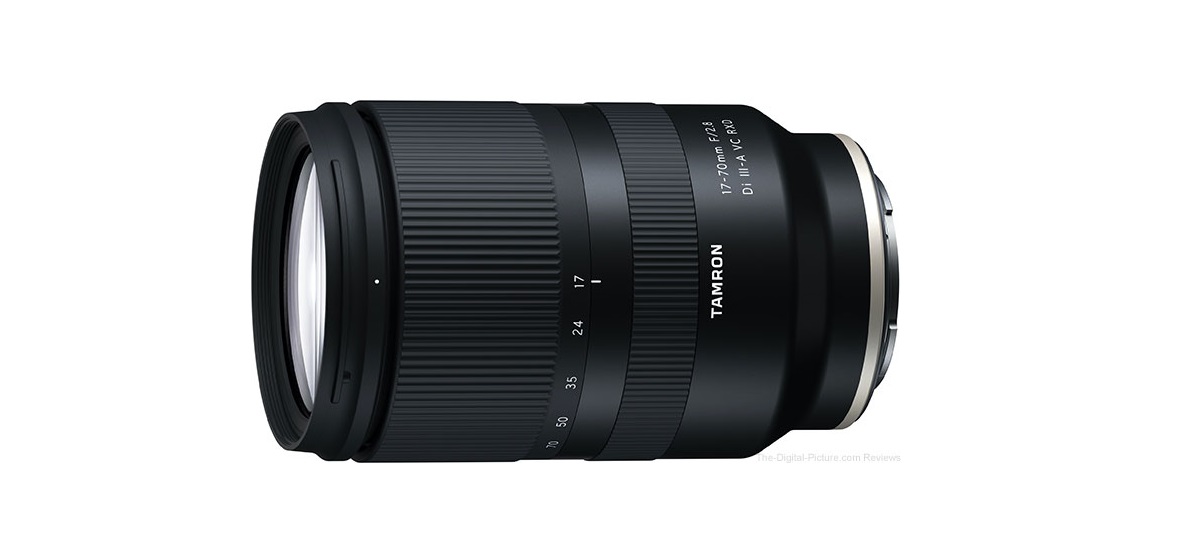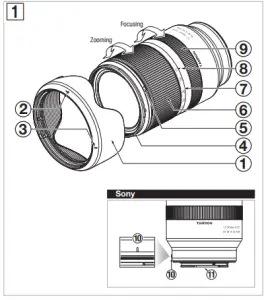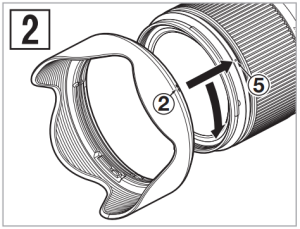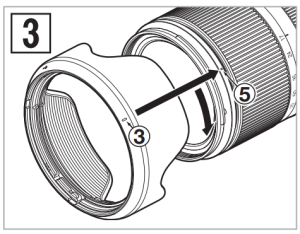Tamron B070 Owner’s Manual
Assembly Instruction
![]() The Marketing is a directive conformity mark of European Community.
The Marketing is a directive conformity mark of European Community.
Thank you for purchasing this Tamron lens. Before using your new lens, please read the contents of this Owner’s manual to properly use the lens.Also, it will be important to read the manual of the camera to which you will attach the lens.After reading, store this Owner’s manual in a safe place.Please read also the document “Precautions for Safe Use of Tamron Lenses” supplied with the lens for the detailed safety precautions to observe when using Tamron lenses.
PART NAMES (Refer to Fig. 1)
- Lens hood
- Hood attaching alignment mark
- Hood locking mark
- Filter ring
- Hood release mark
- Zooming ring
- Focal length scale
- Focal length mark
- Focus ring
- Lens attachment mark
- Lens camera interface contacts
MAIN SPECIFICATIONS
- ModelB070
- Focal Length17-70 mm
- Maximum ApertureF/2.8
- Angle of View (diagonal)79˚55′ – 23˚00′
- Optical Construction12/16
- Minimum Object Distance(Mode)0.19 m (7.5″) (Wide) / 0.39 m (15.4″) (Tele)
- Maximum Magnification Ratio1:4.8 (Wide MOD) / 1:5.2 (Tele MOD)
- Filter Sizeø67 mm
- Length119.3 mm (4.7″)
- Maximum Diameterø 74.6 mm
- Weight525 g (18.5 oz)
- Lens HoodHA036
- Length : From tip of front element to mount surface.
- Specifications, appearance, functionality, etc. are subject to change without prior notice.
ATTACHING AND REMOVING THE LENS
Remove the rear cap of the lens. Align the lens attachment mark ⑩ and mounting mark on the camera, and then insert the lens. Turn the lens clockwise until it locks. To remove the lens, turn the lens in the opposite direction while pressing the lens release button on the camera.
- Turn off the power of the camera before attaching or removing the
- For details, please read the instruction manual of your camera.
SWITCHING FOCUS MODE
Select the desired focus mode on the camera.For manual focusing, turn the focus ring ⑨ to acquire the desired focus. For details, please read the instruction manual of your camera.
- Under AF mode, there may be difficulty for autofocus to work depending on the subject.
VC MECHANISMThe VC (Vibration Compensation) mechanism reduces image blur caused by hand-held shooting.
How to use VC
To activate VC, set your camera steady shot function “ON” in the camera. If the VC is not needed, turn the steady shot function “OFF”.Press the shutter button halfway and confirm that the viewfinder image is stable before taking a picture.
VC is effective under the following conditions
- Dimly lit locations.
- Locations where flash photography is prohibited.
- Locations where tripod cannot be used.
VC may not perform sufficiently under the following conditions
- When a photograph is taken from a vehicle that is shaking greatly
- Shooting during excessive movement of the camera
- When shooting while using a tripod
- Deactivate steady shot setting in the camera when taking pictures under bulb photography (long exposures). Otherwise, VC may cause a malfunction.
- The viewfinder image may become blurred immediately after the shutter button is pressed This is due to the principles of VC and not a malfunction.
- When using VC, the total number of images recordable will be reduced due to the camera power
- Deactivate the vibration compensation in the camera settings when you are shooting while the camera is secured by something other than your hand (such as a tripod).
- You may feel the lens rattle when the camera is turned off or when the lens is removed from the This is not a malfunction.
- For details, please read the instruction manual of your camera.
ZOOMING (Ref. Fig. 1)
Turn the zooming ring ⑥ to adjust the focal length (Zoom position) to a desired position.
LENS HOOD (Ref. Figs. 2, 3)
A bayonet-type lens hood ① is provided as standard equipment. We recommend shooting with the hood properly attached because the lens hood eliminates stray light that may affect the picture
Using the lens hood (Ref. Fig. 2)
Align the hood attaching alignment mark ② of the hood with the hood release mark ⑤ of the lens. Rotate the hood ① in the direction of the arrow until the hood locking mark ③ meets the hood release mark ⑤.
Stowing the lens hood (Ref. Fig. 3)
You can stow the lens hood ① by attaching it in reverse. Align the hood locking mark ③ of the hood with the hood release mark ⑤ of the lens. Rotate the hood ① in the direction of the arrow until the hood attaching alignment mark ② meets the hood release mark ⑤.
- Be aware that the perimeter of the photographed image may be darkened if the hood ① is not attached
USAGE PRECAUTIONS
- An internal focusing (IF) system is employed to reduce the minimum focus The angle of view may be wider than that of lenses with other focusing systems when shooting at a distance less than infinity.
- The lens hood or the lens barrel may block the light from the It is recommended to perform trial shooting in advance.
- Differences in the display systems of cameras may cause to show values different from the maximum and minimum aperture values from the This is not an indication of an error.
- Do not touch the lens-camera interface contacts with your Otherwise, it may cause a malfunction.
- If the temperature changes suddenly, condensation may form and cause
- The front element is covered with stain-proof After removing the dust on the lens surface with a blower or another means, wipe it with a dry cloth.
- Never use benzene, thinner, or other organic solvents to clean the
- Store the lens in a clean and well-ventilated
- For more details on the lens cleaning and storage, the compatibility with cameras, and other support information see our https://www.tamron.jp/en/support/
![]() Disposal of Electrical and Electronic Equipment in Private Households. Disposal of used Electrical & Electronic Equipment (Applicable in the European Union and other European countries with separate collection systems)
Disposal of Electrical and Electronic Equipment in Private Households. Disposal of used Electrical & Electronic Equipment (Applicable in the European Union and other European countries with separate collection systems)
This symbol indicates that this product shall not be treated as household waste. Instead it shall be collected separately for the recycling of electrical and electronic equipment.If the new products are purchased, this product might be handed over to the distributor or the collection system of waste electrical and electronic equipment eventually.By ensuring this product is disposed of correctly, you will help prevent potential negative consequences for the environment and human health, which could otherwise be caused by inappropriate waste handling this product or components of this product.If this product is disposed illegally, it might cause a possibility of penalties. For more detailed information about recycling of this product, please contact your local Civic Office, your household waste disposal service or the shop where you purchased the product.
Precautions for Safe Use of Tamron Lenses
For safe operation be sure to carefully read the “Precautions for Safe Use of Tamron Lenses” and the manual before using the product.After reading them, store them in a place where they can easily be reviewed whenever needed. Caution instructions are divided into the following two categories according to the degree of danger involved
![]() WARNINGThis indicates instructions which if not followed or if performed incorrectly could lead to death or serious injury
WARNINGThis indicates instructions which if not followed or if performed incorrectly could lead to death or serious injury
- Do not view the sun or other strong light source directly through the lens or through a camera while using this lens.
- Doing so could cause loss of vision, damage to the lens and/or the camera, and possibly cause the lens and/or camera to ignite.
- Do not dissemble, repair, or modify the lens.
- This could damage the lens or camera.
- Keep the lens out of the reach of small There is a risk of injury if the lens is dropped or falls down.
![]() CAUTIONThis indicates instructions which if not heeded or if performed incorrectly could lead to bodily injury or physical damage
CAUTIONThis indicates instructions which if not heeded or if performed incorrectly could lead to bodily injury or physical damage
- Do not place lens in direct sunlight or leave it in an extremely hot place such inside a Doing such could damage the internal parts of the lens or cause a fire.
- Always attach the lens cap whenever the lens is not in use.
- When attaching the lens to the camera, ensure that the lens has been properly attached to the camera and firmly locked.
- If the lens is not attached properly, it could be difficult to remove or it could fall off causing damage or injury.
- Do not use this lens for any application other than photography.
- Do not transport the lens while it is still attached to a tripod.
References
[xyz-ips snippet=”download-snippet”]




